Kraków 2009-08-30
History
188b Section 1964-04-14.
OKB Mikojan and Guriewicz MiG-21 PF in Poland.
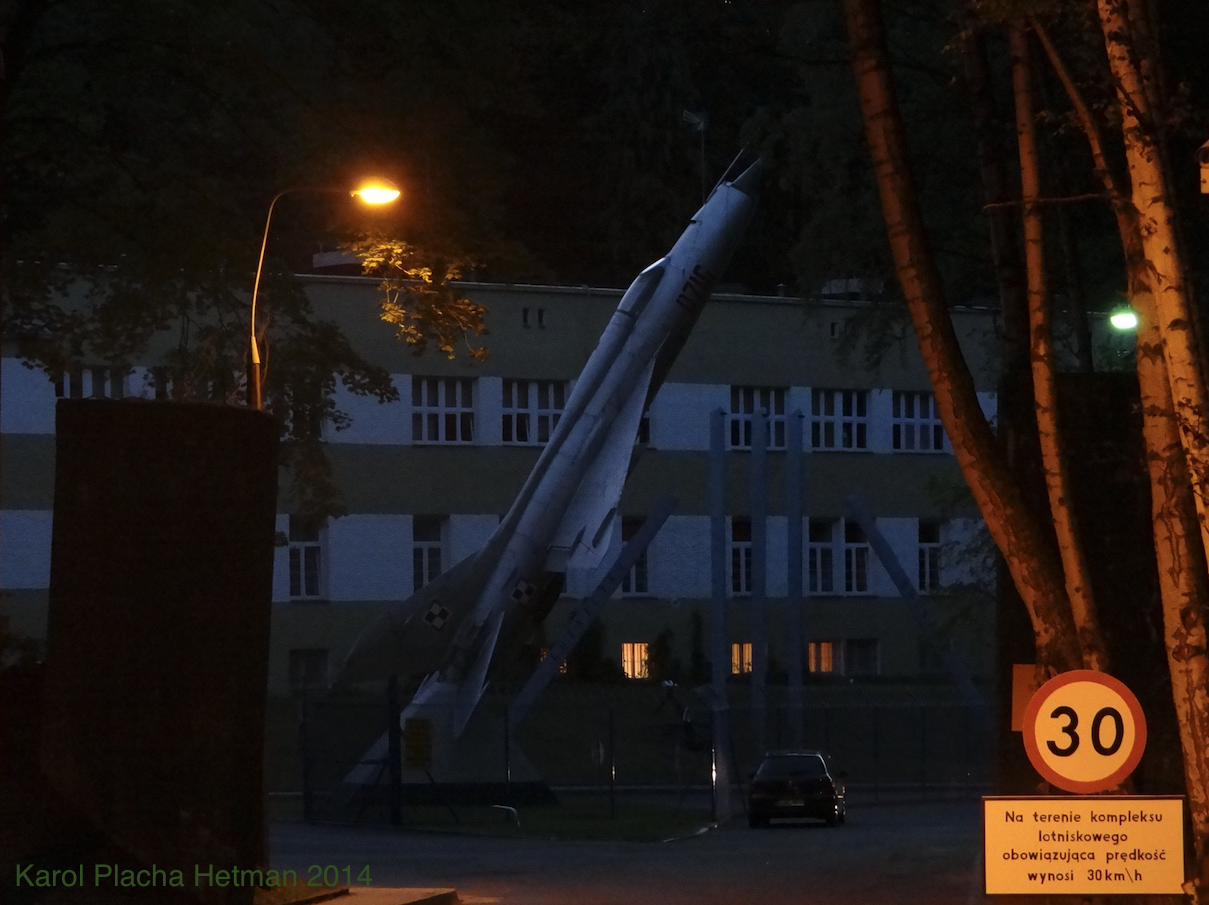
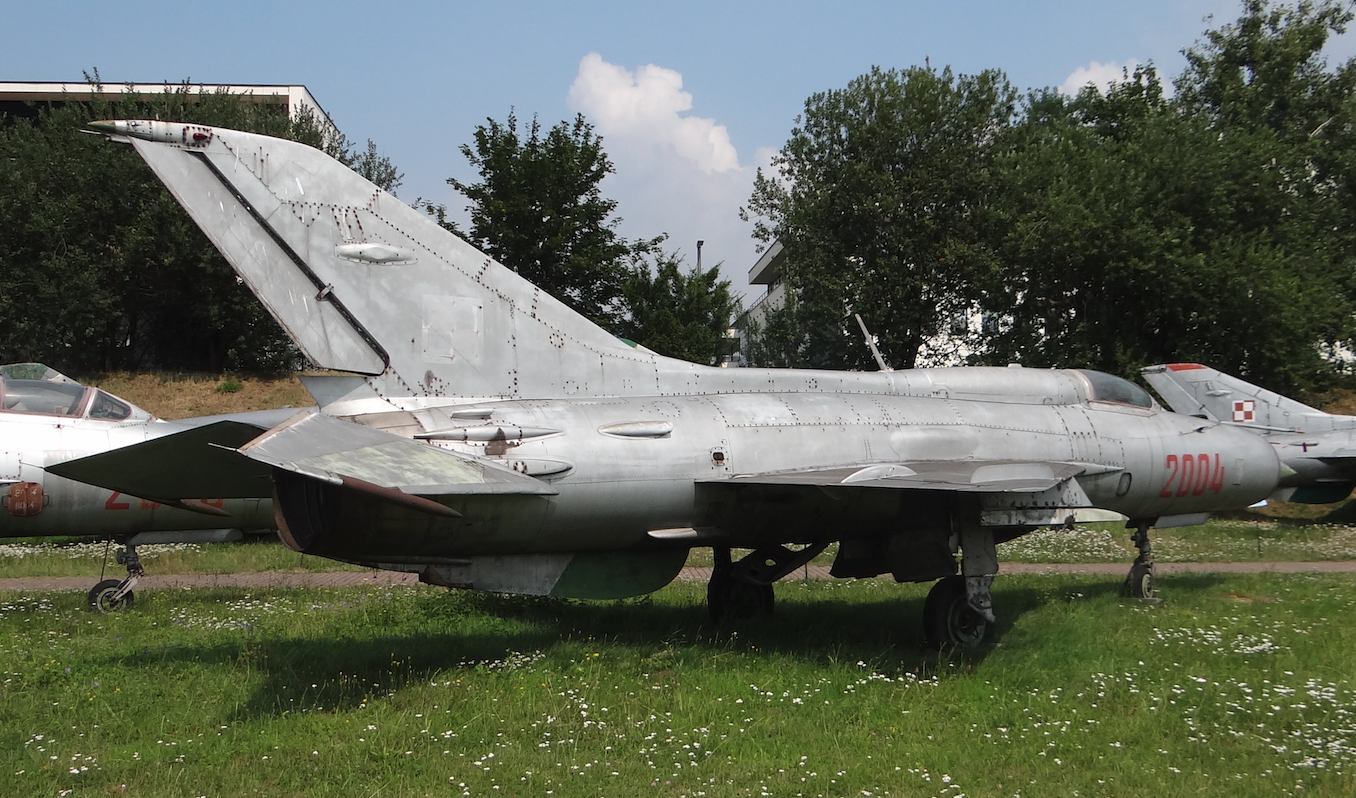

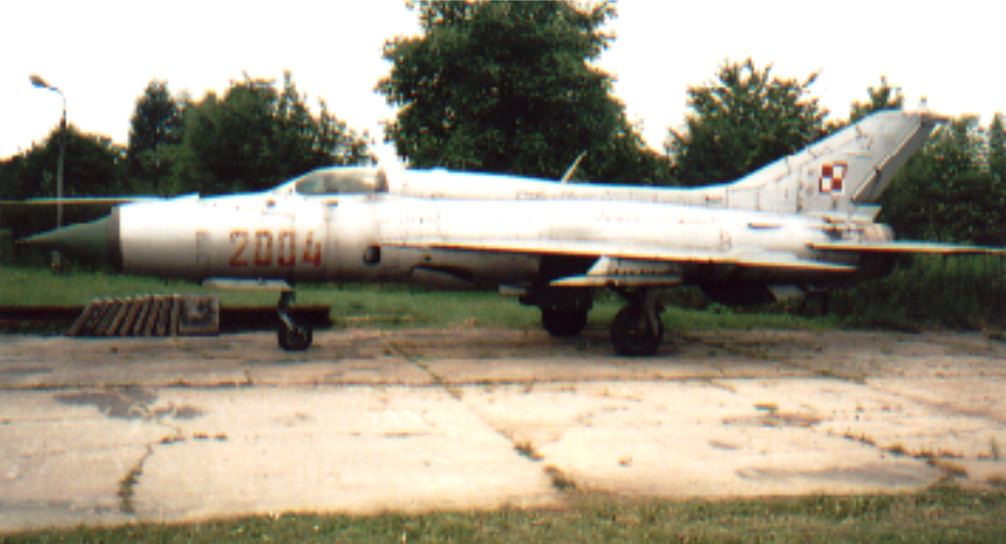
During the development of the MiG-21 fighter, the requirements for the weapon system increased. Ultimately, the front fighter was to have the ability to combat air targets day and night in "all weather conditions". In this way, Mikojan, after several years, again gained the opportunity to build fighters immediately equipped with radar stations (radar sights).
MiG-21 P.
The new requirements were implemented in the E-7 prototype. Changes in construction and equipment compared to the E-6 were huge. The front of the hull was enlarged to accommodate new equipment, and above all the CD-30 radar station. Her antenna was in the enlarged inlet cone. To use the radar sight better, the armament had to change. CCP appeared p-p class RS-2 U. The plane has been able to cooperate with the Wozduch-1 ground-based guidance system via the Lazur radio receiver. In addition, equipment appeared; query and response device (IFF in English), KAP-1 automatic pilot and larger wheels for using ground airports. Plots and SPO-2, RW-UM, RUM were not mounted on the new fighter. ASP-5 N (red dot sight with rangefinder) replaced the simple red dot sight with PKI collimator.
As for the lack of cannons, the concept of a single rocket attack from the greatest possible distance and avoidance of maneuvering combat, in accordance with the doctrine of its disappearance, took over.
On April 9, 1959, the E-7/1 prototype made its first flight, with pilot P. M. Ostapienko. In one of the flights, at maximum speed (pilot I. N. Krawcow), the aircraft lost lateral stability and the pilot catapulted. The machine was lost. Tests continued on E-7/2 and E-7/3. Both aircraft were flown in 1960.
On May 8, 1960, the factory tests came to an end, and from June 1960, the factory in Gorki began mass production of machines under the designation MiG-21 P type 76 (pieriechwatczik). On state tests, the operation of the radar station and the insufficient range aroused reservations. Few machines of this type were finally armed with the Code of Civil Procedure. K-13 and operated under the designation MiG-21 P-13.
MiG-21 PF.
It was only the E-7/4 aircraft that succeeded, which in August and September 1962, successfully passed factory tests and was directed to production under the designation MiG-21 PF (again type 76). The aircraft received a CD-30 T radar station, which in production was designated RP-21 and RS-2 US missiles. Interestingly, however, the possibility of carrying K-13 missiles was retained. The radar station detects the bomber at a distance of 20 km, and automatic tracking starts at a distance of 11 km. The armament for attacking ground targets remained unchanged and its load capacity was still 500 kg.
The MiG-21 PF aircraft received a more powerful R-11 F2-300 engine with 1 x 3 870 kG thrust, with 1 x 6,000 kG afterburning. The fuel installation reached a capacity of 2,780 liters by adding an over-fuselage seventh tank with a capacity of 170 liters. In addition, the fighter received the KAP-2 (KAP-2 K) autopilot, the front air brakes were increased from 0.760 m 2 to 0.884 m 2, the probe was moved to the air inlet.
MiG-21 PF was produced in Gorki for the needs of the Red Army in 1962-1964, and for export in 1964-1966.
MiG-21 PF in Poland.
On April 14, 1964, the first MiG-21 PF units equipped with RP-21 radar stations, RS-2 US missiles guided by a radar system, increased fuel supply and several other novelties were delivered to Polish Aviation. These aircraft represented a completely new quality, because, unlike the previous version, they could actually work day and night, in all "all weather conditions".
The first four MiG-21 PF planes were accepted as 62. PLM on April 14, 1964, and the next two machines on October 26, 1964, just like in the case of the first version of the MiG-21 F-13, and now Krzesiny has become the basis for transmission by Soviet side of the MiG-21 PF aircraft. Since the 62nd PLM operating in Krzesiny was a combat unit, it gained the greatest experience in the operation of MiG-21 F-13 and MiG-21 PF fighters. Therefore, CSL (Aviation Training Center) in Modlin began to lose its rank. Pilots from the 3rd PLM from Wrocław, 13th PLM from Łęczyca, 26. PLM from Zegrze Pomorskie, 40. PLM from Świdwin, 41. PLM from Malbork were trained in Krzesiny.
By the end of 1964, 21 (17) aircraft were imported. All fighters were deployed several regiments, creating special duty pairs on their basis. These were the following regiments; 1. PLM in Mińsk Mazowiecki, 3. PLM in Wrocław, 11. PLM in Debrzno then in Wrocław, 26. PLM in Zegrze Pomorskie and 62. PLM in Krzesiny and CSL in Modlin.
26 PLM in Zegrze Pomorskie selected its group of pilots for training on the MiG-21 PF in 1963, and planes in Zegrze Pomorskie appeared in August 1964. But from receiving planes to achieving operational (combat) readiness the road is long. The first rocket shooting was carried out only in 1968.
At the beginning of 1965, MiG-21 PF fighters also began to be sent to operational aviation regiments. At the beginning, two machines received 40. PLM and 41. PLM. In mid-1965, the 40th PLM in Świdwin received another batch of 15 MiG-21 PF No.; 761713, 761808, 761809, 761810, 761811, 761812, 761813, 761815, 761903, 761904, 761911, 761913, 762003, 762004, 762005. Such a large number of machines delivered to this unit in the first place was caused by its participation in the WOPK on-call system towards the seaside. Also in mid-1965, the 41st PLM received another MiG-21 PF. And so on May 16, 1965, the first MiG-21 PF No. 761814 was added, and on July 10, 1965, two MiG-21 PF No.; 761901, 761902.
On 10.07.1965, as part of another delivery of the 62nd PLM received the last 5 MiG-21 PF machines. For the period from April 1964 to October 1965, pilots of the 1st squadron flew on both versions of the MiG-21 F-13 / PF aircraft, when the MiG-21 F-13 machines were transferred to the 4th PLM in Goleniów (Air Force). In 1966, the regiment in Krzesiny also received one combat-training MiG-21 U.
In total, Poland bought 85 (other sources state 84) machines. It was already a considerable number of machines. Deliveries were completed in 1966, or more precisely at the beginning of 1966, the handover of machinery to Polish Aviation by CCCP was completed in Krzesiny.
60 machines went to WOPK (National Air Defense Forces), and 24 machines to WL (air forces – Operational Aviation). The aircraft were in the state of the next regiments; 4. PLM in Goleniów, 10. PLM in Łask (since 1968), 39. PLM in Mierzęcice. In total, the machines went to eleven combat regiments and to technical staff schools in Zamość and Oleśnica.
Regiments 4. PLM in Goleniów and 40. PLM in Świdnica were part of the 3rd Brandenburg Fighter Division (LO), whose name was given to Order MON No. 55 / MON of October 7, 1963. Previously the division was called 5. BDLM. At that time, the division’s commander was a colonel qualified pilot Wiktor Iwoń (1957-1965). The personnel of the 4th PLM in Goleniów and 40. PLM in Świdwin began to familiarize themselves with the new aircraft in 1964, but the unit’s own machines were not received until 1965. On April 1, 1965, both regiments received one squadron of MiG-21 PF fighters. The merits of these units include the first in the country making take-offs and landings with MiG-21 aircraft on DOL (road route). The first pilot who did this was Captain Zbigniew Biedrzycki from the 4th PLM.
On March 6, 1971, according to the ordinance of the Chief of General Staff No. 012 / Org. 3. BDLM was renamed the 3rd Brandenburg Assault Aviation Division. Tasks are changing and that is why 4. PLM in Goleniów passes under another division, and 40. PLM disposes of MiG-21 aircraft.
Regiment 10. PLM in Łask received its first MiG-21 aircraft in 1968, when its commander was Lt. Col. Dipl. pil Józef Radonia. This regiment was also served by the later commander of the WLOP weapon gene pil Jerzy Gotała. MiG-21 PF took over the first planes for the regiment (6 units) in March 1968, from the 3rd PLM. Another 6 pieces of MiG-21 PF were taken over in April 1968, from the 1st PLM in Mińsk Mazowiecki. Among these 12 machines were; 761506, 761608, 761610, 761614, 761708, 761712. In August 1970, another 10 MiG-21 PF aircraft were accepted. In 1971, another 7 MiG-21 PF aircraft from 13th PLM and 39th PLM were accepted. In subsequent years, single copies were accepted. In the period from March 1980 to October 1980, eight MiG-21 PF aircraft from 39. PLM were accepted. The last MiG-21 PF aircraft was accepted into the regiment on March 9, 1984.
The MiG-21 PF regiment 10. PLM finally bade farewell in 1989, when several machines were immediately deleted at the airport, and the rest was transferred to BSP in Mierzęcice.
MiG-21 PF aircraft in Polish aviation served for a very long time. The last 39 units were removed from the state in 1989 as part of arms reduction. MiG-21 PF was a typical representative of the rocket era in aviation. There has been talk about the twilight of the plane as a means of combat, and only as a carrier of missiles. In the UK, plans to build any piloted aircraft have been completely abandoned. In the US, the F-106 fighter was to be almost completely automatic, with only takeoff and landing being carried out by a pilot. Therefore, we are not surprised that the MiG-21 PF aircraft were deprived of cannons.
What was the theory of the MiG-21 PF attack supposed to look like?
After take-off, the pilot, still in communication with the SD (Command Post) or PN (Guidance Point), is directed to a specific course and takes the appropriate ceiling. The targeting is carried out using the visual-phonetic method or on the instruments via the ARŁ-S "Lazur" telemetry radio link. The MiG-21 PF, unlike the MiG-21 F-13, already had this device. When the plane is at the right distance from the enemy, it only launches SR, intercepts the target, performs an attack and returns to base. The attack was to be one-off. In combat conditions, the distance was several kilometers. In training flights about 20 km.
We know that this pattern has not stood the test of time, as confirmed by subsequent armed conflicts. Therefore, even in the 80s, despite losing many of its combat properties, the MiG-21 PF could be an effective weapon. With a good organization of the fight, taking into account all the restrictions of the aircraft, it could be successfully fought. Good tactics, i.e. the use of demonstration groups at high ceilings with SR on, simulation groups pretending to be e.g. attack on ground targets, low-impact strike groups, hidden on the ground ready to attack, changes in group composition, withdrawal of machines with low fuel supply. The efficiency of operations would increase with the DRŁO system, the equivalent of AWACS, which Poland did not have, but did not have CCCP in service.
In Poland, aerial shooting, usually in the form of glowing bombs, was carried out at the Ustka training ground. Real firing (shooting) of the NCR missiles for flying maneuvering and non-maneuvering purposes, MiG-21 PF aircraft in Poland were not operated. These exercises were performed in the CCCP, on the training ground located outside the Caspian Sea. These exercises were carried out no more than once a year, due to the high costs. A selected group of pilots, guidance navigators, communication specialists, radio engineering group, flight insurance and armament technicians, after successfully passing the exercises at the Ustka training ground, went to CCCP with transport aircraft. There was always a group of officers from the DWL (Air Force Command) and the Command of the training division. Only Soviet equipment was used. After learning about the equipment, exercise began. They started with fighting the non-maneuvering target, then the target maneuvered, and finally tactical elements, i.e. approximation to war conditions, were introduced. The air target was usually La-17 in various forms, e.g. MM.
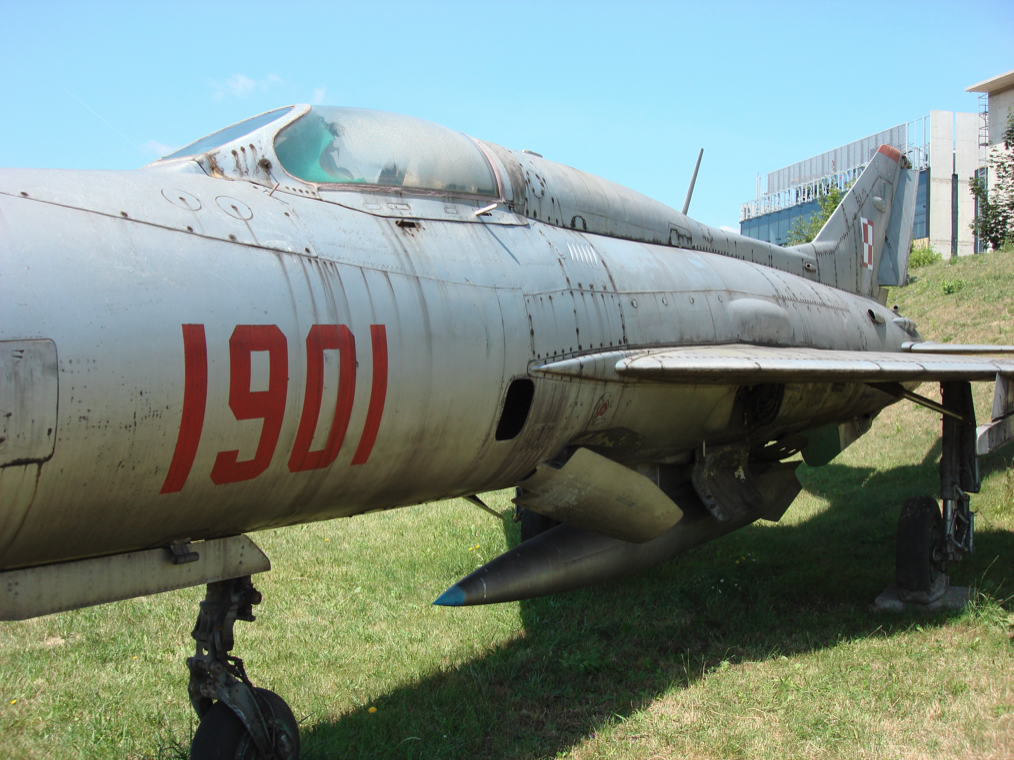
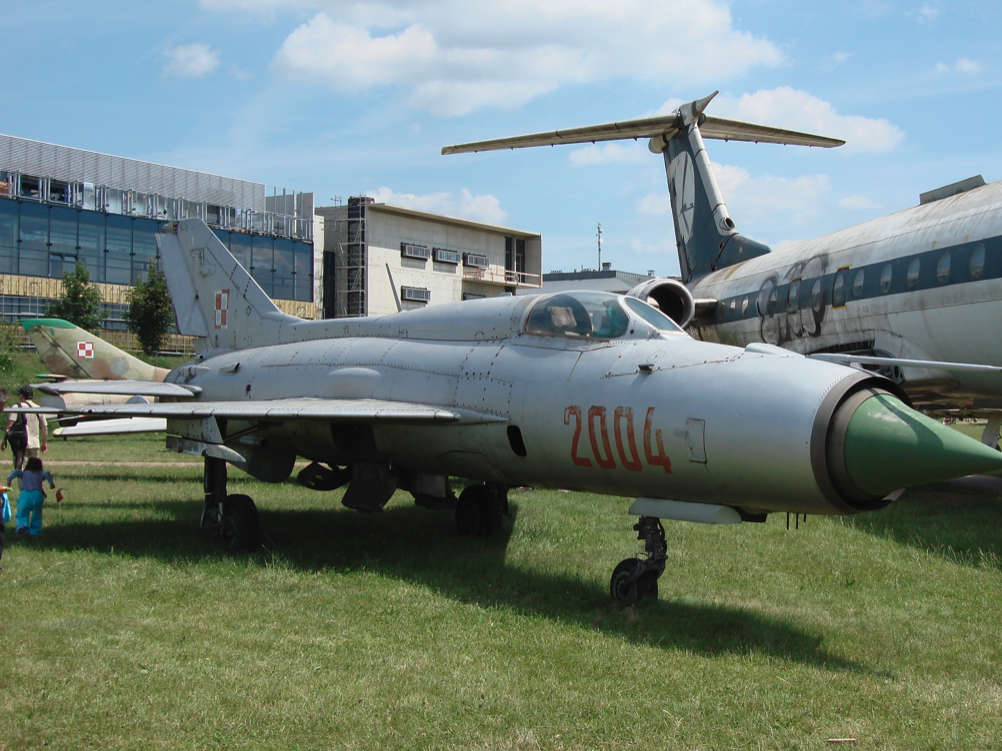
One-sided reinforcement reduction.
Along with the political changes in Poland at the turn of 1989-1990, the authorities decided to relieve the country’s budget and alleviate the society, among others by limiting expenditure on armaments. One of the elements of such a policy was unilateral arms reduction. It consisted in decommissioning several dozen MiG-21 PF combat aircraft. To show that this was implemented, in the 10th PLM in Łask, several aircraft were dismantled in the company of cameras and cameras. On January 15, 1990, MiG-21 PF No. 760610, 760702, and 762006 were certainly scrapped.
Disasters, accidents and breakdowns of MiG-21 PF aircraft in Poland.
In 1967, there was a black series of MiG-21 aircraft accidents. In total, eight aircraft crashed. They were particularly sad for the 26th PLM from Zegrze Pomorski, where two young pilots were killed. They were probably MiG-21 PF planes.
On January 28, 1967, the MiG-21 PF from the 41st PLM in Malbork suffered an accident. Pilot lieutenant Sławomir Szczawiński survived. Malbork airport.
On April 17, 1967, the accident was MiG-21 PF nb 2008 No. 762008 from the 26th PLM in Zegrze Pomorskie. Pilot lieutenant Czesław Rawski was killed. Around the village of Racibórz Polanowski. The plane collided with the ground. The cause has not been established.
On September 28, 1967, the MiG-21 PF from the 26th PLM had an accident. Lieutenant pilot Mieczysław Brańka was killed. Around the village of Mostowo. The accident happened during night flights under normal atmospheric conditions, during landing. The causes of the disaster have not been established.
On January 22, 1968, the accident was MiG-21 PF No. 762403 nb 2403 from the 1st PLM. Pilot lieutenant Walety Ziętek survived. Around the village of Zasiadły.
On August 12, 1969, the MiG-21 with 34 PLM in the vicinity of the village of Tuławki suffered an accident. Pilot captain Piotr Kromołowski survived (died).
On April 2, 1970, MiG-21 PF No. 761712 nb 1712 with the 10th PLM near Szydłowiec suffered an accident. Lieutenant pilot Wiesław Bolek survived (died).
On November 9, 1970, the MiG-21 PF from the 1st PLM near Pęcław suffered an accident. Pilot lieutenant Wiktor Panczyj survived (died).
On May 6, 1971, the MiG-21 PF (PFM) with 34th PLM at the airport in Mierzęcice suffered an accident. Major Pilot Alfred Grzechulski survived (died).
On May 11, 1971, at the 40th PLM airport in Świdnica, the MiG-21 PF nb 0905 No. 760905 collided with the MiG-21 U nb 1219 aircraft.
On 3.07.1973, the accident was the MiG-21 of the 26th PLM Zegrze Pomorskie. Pilot por Henryk Zieliński was killed. He performed the task of flight for air combat in the daytime. The causes of the disaster have not been established.
On August 14, 1978, the accident was MiG-21 PF nb 0704 No. 760704 with 62 PLM. The pilot survived.
On March 22, 1979, the accident was MiG-21 PF nb 1705 No. 761705 with 62 PLM. The pilot survived.
On March 22, 1979, the MiG-21 PF from the 10th PLM over the Nowa Dęba training ground suffered an accident. Pilot captain Walenty Giegiel (survived-killed).
On August 2, 1979, the accident was MiG-21 PF nb 2409 No. 762409 from 11th PLM. The pilot survived.
On 09.07.1981, the accident was the MiG-21 PF from the 1st PLM near the town of Drążewo. Lieutenant pilot Krzysztof Czerwiński survived (died).
On February 18, 1984, the accident was the MiG-21 PF from the 1st PLM near Kolonia Czarno. Pilot captain Jerzy Moryc survived (died).
On May 21, 1985, the MiG-21 PF from the 1st PLM at the airport in Minsk Mazowiecki was involved in an accident. Pilot lieutenant Stanisław Lubojański survived (died).
On February 23, 1986, the accident was MiG-21 PF nb 1711 No. 761711 from 62. PLM. Pilot’s fate unknown.
Written by Karol Placha Hetman

